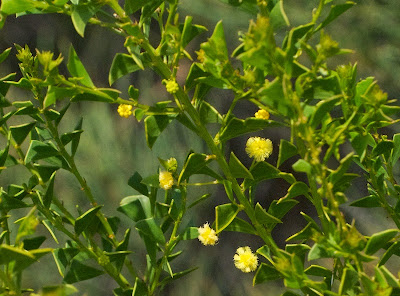On September 15, 2013, we set off, with our friend Rita Shii and her companions, on the second leg of our wildflower tour of Western Australia. This time we headed north out of Perth, bound for Jurien Bay and the fabulously rich flora to be found around it. Our first stop was a famous, if very strange, tourist destination: the Pinnacles, the chief attraction of Nambung National Park.
Here we are, ready to do some exploring. That's Rita in the middle, and of course Eileen on the right.
Australia has vast quantities of desert, but the desert at Nambung is something rather different. Rather than being a part of the celebrated Great Red Centre, it is an isolated patch of sandy country in an otherwise well-vegetated patch of coastal heathland.
The desert at Nambung is one of Australia's most peculiar landscapes, thanks to its weird array of pinnacles. I confess pictures of the place, plus the name, had led me to expect towering, skyscraper-sized columns of stone, but in reality (as the photo at the top of this post reveals) the "pinnacles" are in reality no more than a few meters high. However, a name like "The Pimples of Nambung" would not have the same effect.
The origin of the pinnacles is as peculiar as their appearance. The
desert they sit in is really a coastal dune system running along an
ancient shoreline, and the limestone that composes the pinnacles is
actually the remains of crushed seashells.
The
calcium carbonate of the ground-up shells leached into the sand during
winter rains, and cemented the sand grains into concrete during the dry
summer season. The roots of growing plants strengthened the growing
layer of cement in some areas, while in others it was eroded away.
The
vegetation was burned away in brush fires, winds carried the remaining
sand grains away, and the remains of this processes are the isolated
pinnacles that we now see.
Today, the pinnacles serve as popular tourist attractions, and as eminently suitable Galah perches. It seems that every set of visitor photos of the pinnacles has to include at least one of a pinnacle surmounted by a pair of birds.
Galahs (Eolophus roseicapillus), as I have said before and will undoubtedly say again, are lovely creatures despite their familiarity (at least to Aussies) and are among my favourite birds.
They can be, as these portraits suggest, absurdly tame. I suspect these two are very familiar with camera-toting tourists, and realize we mean them no harm.
As I mentioned above, the Pinnacles Desert is really more of a dune system than a desert proper, and if you look in the right direction you can see a fair bit of vegetation.
From the visitor's centre, in fact, you can look past an almost unbroken expanse of coastal heath to the shores of the Indian Ocean.
The shrubbery near the dunes included plants typical of Australian dry country, including wattles. This one, which I think is Acacia rostellifera, is typical of many arid-land acacias. The feathery leaves of typical acacias have been lost, replaces with flattened stems, or phyllodes, that have taken up the photosynthetic duties of the former leaves but are less likely to lose water.
The phyllodes on this Acacia are certainly distinctive-looking, but I haven't been able to determine which species this is. There are just too many of them!
She-oaks (Allocasuarina sp) are also typical of dry country. Like wattles with phyllodes, they have reduced their leaves (to a tiny crown of pointed triangles at each stem node), and are less likely to lose water than leafier plants.
Other shrubby plants belong to genera we had already met farther south: Cutleaf Hibbertia (Hibbertia cuneiformis), here at the northern end of its range...
...and Parrot Bush (Banksia sessilis), another of the dryandras, and an important source of food for nectar-feeding birds over much of the southwest.
As usual, there were plants I duly photographed but have failed to identify. What is this?
Yellow Tailflower (Anthocercis littorea), a member of the tomato family (Solanaceae), prefers limestone sand, so it is no surprise to find it here. It grows around much of the southwestern coast (its species name, littorea, means "near the seashore"), and its presence here is another remonder that this is a coastal dune system.
We found our share of alien weeds, of course (I know these are weeds, but don't ask me which ones!).
This weed I do know: Capeweed (Arctotheca calendula), a native of South Africa.
As we were leaving, I stopped at a hedge near the visitor centre overgrown with White Clematis (Clematis pubescens), another species I had met further south.
Its flowers were still blooming...
...but, perhaps because we were farther north and a week later in the season, it also carried a lot of feathery seed heads.
The hedge was popular with local honeyeaters. This is a Singing Honeyeater (Lichenostomus virescens), one of the most widespread Australian species.
And here is one of my favourites, the handsome White-cheeked Honeyeater (Phylidonyris niger), a bolder cousin of the common New Holland Honeyeater (P. novaehollandiae), and a bird I am always glad to see.

















%2BDSC_1602.jpg)
%2BDSC_1611.jpg)
%2BDSC_1614.jpg)
%2BDSC_1630.jpg)
%2BDSC_1632.jpg)





%2BDSC_1562.jpg)
%2Bsessilis)%2BDSC_1560.jpg)
%2Bsessilis)%2BDSC_1595.jpg)


%2BDSC_1649.jpg)
%2BDSC_1646.jpg)

%2BDSC_1650.jpg)
%2BDSC_1678.jpg)
%2BDSC_1655.jpg)
%2BDSC_1657.jpg)
%2BDSC_1662.jpg)
%2BDSC_1681.jpg)
%2BDSC_1673.jpg)
%2BDSC_1674.jpg)
%2BDSC_1693.jpg)
%2BDSC_1695.jpg)
%2BDSC_1697.jpg)
No comments:
Post a Comment